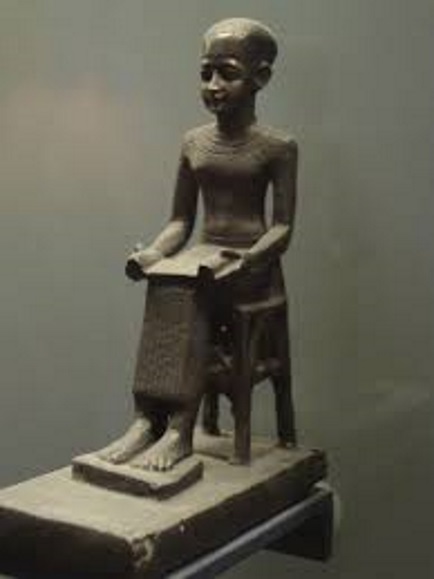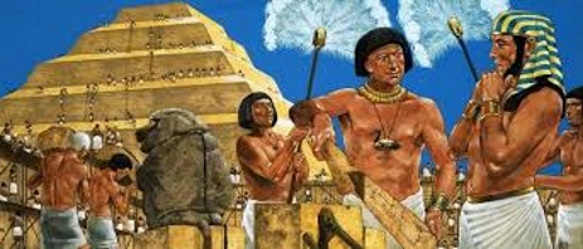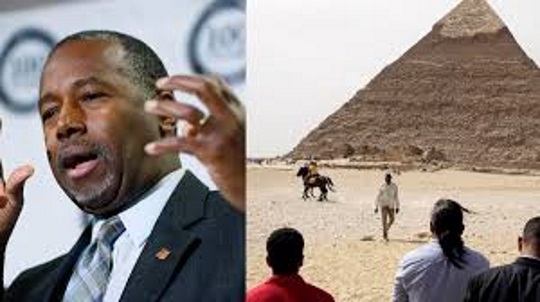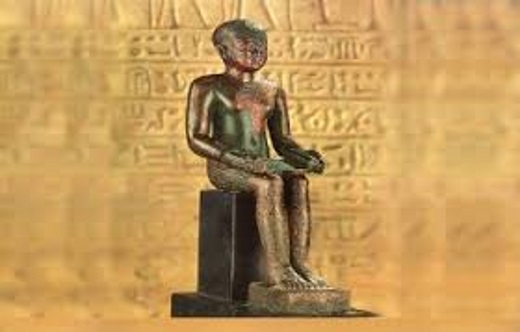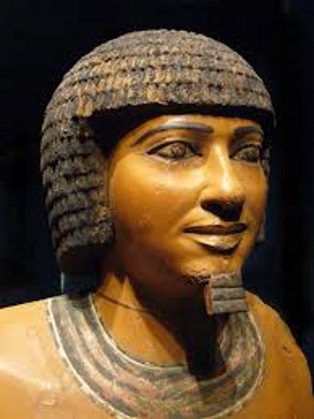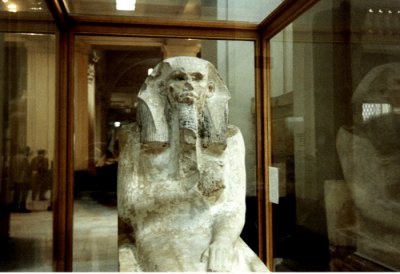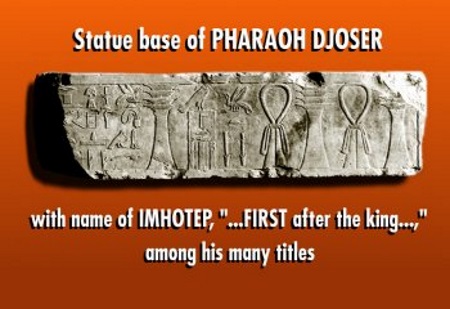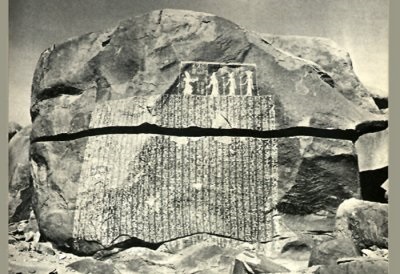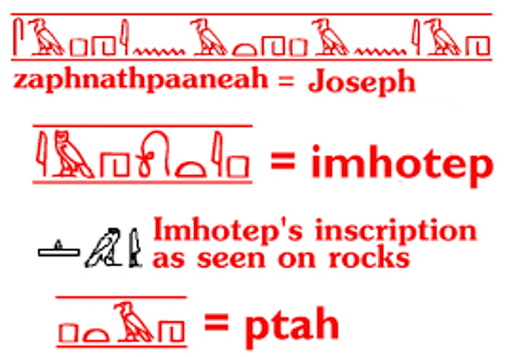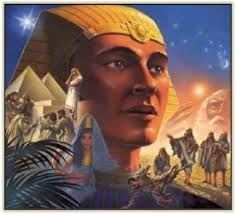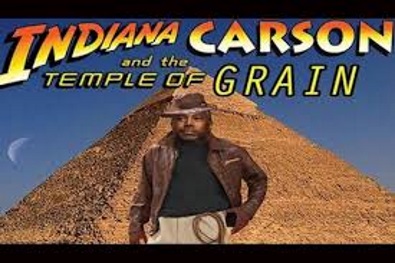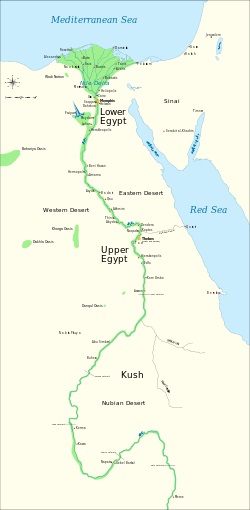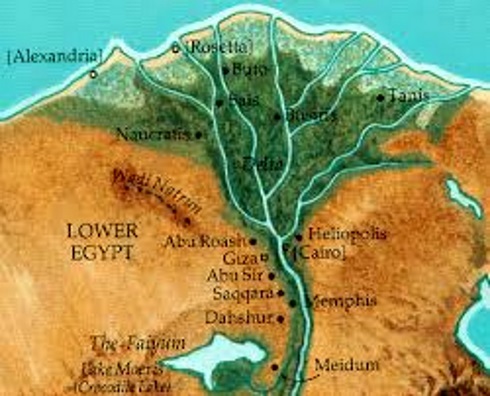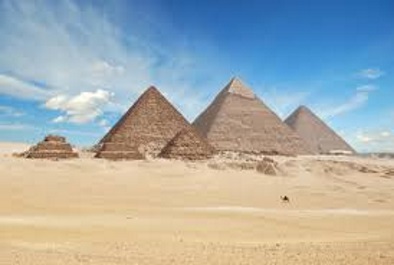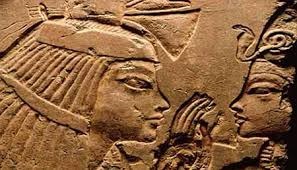|
IMHOTEP AS JOSEPH Unauthorized Research in Non-Bible Sources
|
|
|
|
Dr. Ben Carson received a lot of unfavorable publicity early in his campaign to become President of the United States because of his stated belief that the Biblical story of Joseph son of Jacob was true, that there was indeed a 7-year famine in Egypt in the days of Joseph, and that one or several pyramids was connected in some way with the storage of grain supervised by Joseph.
Joseph in Ancient Egyptian History From: http://www.wyattnewsletters.com/joseph/joseph01.htm by: Mary Nell Wyatt (Originally published in Newsletter No. 7, April 1994)
There is also a picture in the tomb of Tehuti-hetep in Bersheh which has a picture of a herd of Syrian cattle entering Egypt with the inscription: "Once you trod the Syrian sands. Now, here in Egypt, you shall feed in green pastures. (Light from the Ancient Past, by Jack Finegan.) According to our chronology, taken from the Biblical record, the flood was in about 2348 BC. Abraham left Haran in about 1921 BC, about 427 years later. Soon after this (we don't know exactly how soon) he and Sarah went to Egypt because of a famine in Canaan. The Biblical account is extremely short on the subject of Abraham's visit to Egypt (Gen. 12:10-20) but we do learn that Abraham misled the pharaoh about who Sarah was- he told him she was his sister. This was partially true since she was his half-sister, but she was also his wife. The pharaoh, because of her beauty, took her to his palace. (Gen. 12:12-15). The king paid Abraham well for Sarah (verse 16) but God intervened, causing some types of plagues to fall upon the pharaoh. (verse 17). When the pharaoh figured out the cause for these inflictions, he called Abraham to account, asking him why he lied to him about Sarah. (verse 18, 19). He then ordered his men to escort Abraham and his entourage out of Egypt. (verse 20). Egypt at this time was already a rich nation, for it was at this time that Abraham became rich in cattle, gold and silver, given to him as payment for Sarah. (Gen. 13:1,2). And there is good evidence that it was at this time that the regulation prohibiting the Egyptians from eating, drinking or fraternizing with foreign shepherds was instituted. (Gen. 46:34). Josephus relates that Abraham was responsible for bringing the knowledge of arithmetic and astronomy to the Egyptians, which may also be true. We believe the time of Abraham's visit to Egypt was early in the 1st Dynasty. It would be about 200 years later when Joseph would be elevated to his high position in Egypt, second only to the pharaoh. And in the 3rd Dynasty, there appears on the scene a most incredible individual in the ancient records- a man called "Imhotep".
IMHOTEP For many years, Egyptologists had doubted that Imhotep had been a real person- they found it rather difficult to believe the various accomplishments credited to him in the accounts written over a thousand years after he was supposed to have lived. At times, Imhotep has been termed the "Leonardo da Vinci" of ancient Egypt, but in fact he was more than that. Da Vinci gained the reputation of a genius- Imhotep was eventually elevated to the status of a god. In Egypt's long list of "gods", very few were ever once living among them. Imhotep was. Manetho wrote that "during his [Djoser of the 3rd Dynasty] reign lived Imouthes [i.e., Imhotep], who, because of his medical skill has the reputation of Asclepius [the Greek god of medicine] among the Egyptians and who was the inventor of the art of building with hewn stone." It was this statement that caused the specialists to doubt the existence of a real man named Imhotep. But in 1926, the question was settled once and for all- Imhotep was a real man.
When excavations were carried out at the Step Pyramid at Sakkara, fragments of a statue of pharaoh Djoser were found.
The base was inscribed with the names of Djoser and of "Imhotep, Chancellor of the King of Lower Egypt, Chief under the King, Administrator of the Great Palace, Hereditary Lord, High Priest of Heliopolis, Imhotep the Builder, the Sculptor, the Maker of Stone Vases..."
Does this fit what we know of Joseph? The Bible is quite clear on his high rank under the pharaoh: GEN 41:40 Thou shalt be over my house, and according unto thy word shall all my people be ruled: only in the throne will I be greater than thou. 43 And he made him to ride in the second chariot which he had; and they cried before him, Bow the knee: and he made him ruler over all the land of Egypt. 44 And Pharaoh said unto Joseph, I am Pharaoh, and without thee shall no man lift up his hand or foot in all the land of Egypt. In fact, it sounds as if Joseph was the first person ever given such honor by a pharaoh, which is confirmed by evidences in Egypt. If this man, Imhotep, was Joseph, surely there must be some evidence tieing him with the Biblical account. Let's take a look... THE EVIDENCE: 1. It begins with the great distress of the pharaoh: "I was in distress on the Great Throne..." GEN 41:8 And it came to pass in the morning that his spirit was troubled; 2. In the inscription, the pharaoh is troubled about a famine and asks Imhotep who the god of the Nile is, so he can approach him about the drought: "... I asked him who was the Chamberlain,...Imhotep, the son of Ptah... `What is the birthplace of the Nile? Who is the god there? Who is the god?'" Imhotep answers: "I need the guidance of Him who presides over the fowling net,..." GEN 41:16 And Joseph answered Pharaoh, saying, It is not in me: God shall give Pharaoh an answer of peace. In the Egyptian text, Imhotep is termed "the son of Ptah", who was the Egyptian god known as the "creator" of everything else, including the other gods. 3. In the inscription, Imhotep answers the pharaoh about the god of the Nile and tells him where he lives. In the Bible, Joseph interprets the pharaohs dream. But, the next thing in the inscription tells that when the king slept, the Nile god Khnum, revealed himself to him in a dream and promised the Nile would pour forth her waters and the land would yield abundantly for 7 years, after a 7 year drought. This passage reflects the fact of a dream by the pharaoh of 7 years of plenty and 7 years of famine, although reversed. 4. The inscription then goes on to record Djoser's promise to the Nile god, Khnum, in which the people were to be taxed 1/10 of everything, except for the priests of the "house of the god", who would be exempted. GEN 47:26 And Joseph made it a law over the land of Egypt unto this day, that Pharaoh should have the fifth part, except the land of the priests only, which became not Pharaoh's. So here we have an inscription which tells a story of pharaoh Djoser asking his vizier, Imhotep, to help him with the problem of a great 7 year famine. Imhotep tells him he must consult the god because the answer is not in him. Then, the pharaoh dreams a dream which foretells the event. Next follow 7 years of plenty, which is reverse from the Biblical account. The pharaoh levies a tax of 10% on all of the population except for the priesthood. The Biblical account tells of a 1/5, or 20% tax, with the priesthood exempt. All of the components of the Biblical account are present in this inscription, except that the story has been "Egyptianized" to fit their religious beliefs.
It is believed that this inscription was written during the 2nd century BC, by the priests of Khnum for the purpose of justifying their claim of some land privileges. Part of the inscription states the pharaoh dedicated some of the land and taxation to the god. But, this isn't the only inscription with this "tale"- there is a similar inscription on the Isle of Philae, only this one has the priests of Isis stating that Djoser made the same gift to their god for the same purpose. Just as the story of the flood is found in almost every ancient culture but is twisted to fit their own purposes and gods, here we find the story of Joseph, only it is twisted to fit the needs of the priests of the various gods in substantiating their claims to certain land.
"Imhotep, the Voice of the God, Im (I AM)" The name, Imhotep, in ancient Egyptian is translated to mean "the voice (or mouth) of Im" however, there is no record of a god in Egypt called "Im". But, we all know the God, "I AM": EXO 3:14 And God said unto Moses, I AM THAT I AM: and he said, Thus shalt thou say unto the children of Israel, I AM hath sent me unto you. JOH 8:58 Jesus said unto them, Verily, verily, I say unto you, Before Abraham was, I am. God told Moses to tell the pharaoh that "I AM" had sent him because "I AM" was the name by which the Egyptians had known Joseph's God. Could "Im" have been "I AM"? The name the Bible states that was given to Joseph by the pharaoh, "Zaphenath-paneah", has been translated by some to mean, "the God lives; the God speaks". Since we do not fully understand the meaning of the Egyptian "hotep", it is quite possible that the translation of Imhotep ("The voice of I AM) is identical to the Biblical name of Joseph ("the God lives; the God speaks).
The Search for Imhotep's Tomb We know from the Bible that Joseph died in Egypt and was embalmed and placed in a coffin. GEN 50:26 So Joseph died, being an hundred and ten years old: and they embalmed him, and he was put in a coffin in Egypt. But, when the children of Israel left during the Exodus, his bones were taken with them: EXO 13:19 And Moses took the bones of Joseph with him: for he had straitly sworn the children of Israel, saying, God will surely visit you; and ye shall carry up my bones away hence with you. This leads us to think that Joseph would have had a royal tomb in Egypt, but that it was possibly taken over and used by someone else, we just don't really know. But one of the big mysteries for Egyptologists has been the tomb of Imhotep- they simply can't find it although they know it should be somewhere in Sakkara. So important is Imhotep to Egyptology, that in the Guidebook to Sakkara by Jill Kamil, "The Tomb of Imhotep" is listed as a subject heading, only to explain that it has not been found. In our discussion of "Imhotep, the Physician", we mentioned that ancient Greek texts speak of a place near Memphis where people came to worship "Imhotep" and be healed. When excavators continued to search for Imhotep's tomb very near the Step Pyramid, they found an incredible labyrinth of underground tunnels, full of mummified ibis (birds) and bulls (in separate galleries). Inscriptions and coins found here show that people came here to be healed! They had found this "sanctuary to Imhotep" written of by the Greeks. After the deification of Imhotep as "god of medicine" , he was given the title, "Chief One of the Ibis"- and this was the connection of this labyrinth with Imhotep. These hundreds of thousands of ibis were mummified and brought here as tribute to Imhotep, filling these tunnels. It was later discovered that these galleries connected to a pit that extends down to a funerary chamber which contains an empty coffin. They also discovered that this chamber belonged to a very large mastaba tomb which contained a second chamber full of broken stone vessels, and in the tomb's storerooms were jars whose clay-stoppers had the seal impression of Djoser! Here is absolute proof that this was the tomb of a very important person of Djoser's reign. No inscriptions were found on the walls and the sarcophagus was empty. But even more importantly, this mastaba is oriented to the north instead of the east, as the other pyramids and mastabas are. This was an important tomb of someone from Djoser's time- but the sarcophagus was empty. There was even found an inscription by an anonymous Greek who came here, telling how he was cured- and it was through a dream! Once again, the evidence speaks loudly of a wonderful story from the Bible- the story of Joseph.
There's a certain correspondence between the Bible "Joseph" story and what has happened in 2015 in Dr. Ben Carson's run for President. Surely a man who dreams of being President of the United States is dreaming of a position in which all his "brethren" would see him as "reigning over them". And that not only his Republican rivals, but quite predictably most of the Democrats would envy him if he achieved marked success in the polls. Which was indeed the case, and some probably Democrat cartoonist made and circulated this cartoon late in 2015. Making fun of Dr. Ben Carson's earlier remarks that he believed the Bible story of the 7 year famine in Egypt to be TRUE, and the story of Joseph's participation in STORING GRAIN to be TRUE, and that this storage was some how or other connected with pyramids (or a pyramid) in Egypt.
Cartoon of Dr. Carson circulated by Democrat Opponents in late 2015 To Move on to Part 2 Click this Line
|
|||||||||||||||||||||||
|
